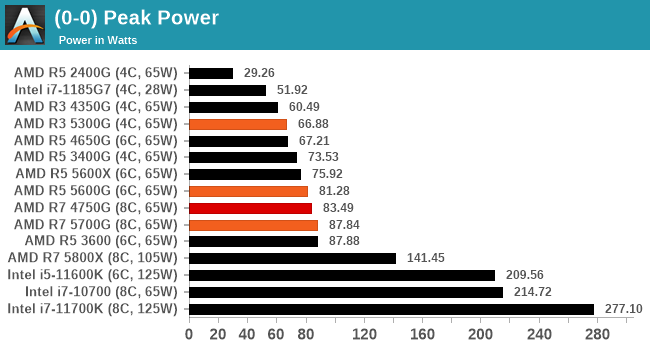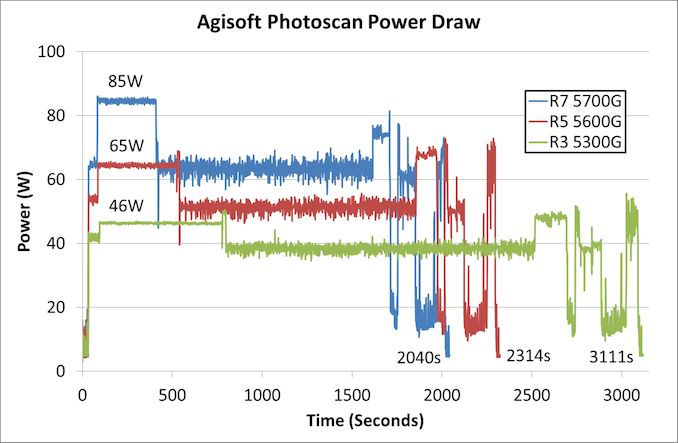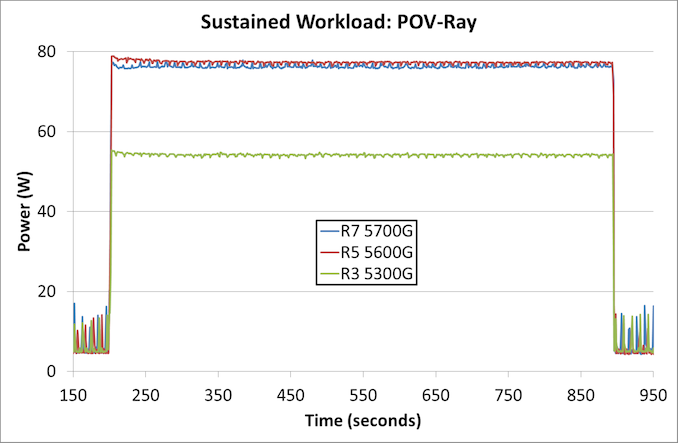The AMD Ryzen 7 5700G, Ryzen 5 5600G, and Ryzen 3 5300G Review
by Dr. Ian Cutress on August 4, 2021 1:45 PM ESTPower Consumption
The nature of reporting processor power consumption has become, in part, a dystopian nightmare. Historically the peak power consumption of a processor, as purchased, is given by its Thermal Design Power (TDP, or PL1). For many markets, such as embedded processors, that value of TDP still signifies the peak power consumption. For the processors we test at AnandTech, either desktop, notebook, or enterprise, this is not always the case.
Modern high-performance processors implement a feature called Turbo. This allows, usually for a limited time, a processor to go beyond its rated frequency. Exactly how far the processor goes depends on a few factors, such as the Turbo Power Limit (PL2), whether the peak frequency is hardcoded, the thermals, and the power delivery. Turbo can sometimes be very aggressive, allowing power values 2.5x above the rated TDP.
AMD and Intel have different definitions for TDP, but are broadly speaking applied the same. The difference comes to turbo modes, turbo limits, turbo budgets, and how the processors manage that power balance. These topics are 10000-12000 word articles in their own right, and we’ve got a few articles worth reading on the topic.
- Why Intel Processors Draw More Power Than Expected: TDP and Turbo Explained
- Talking TDP, Turbo and Overclocking: An Interview with Intel Fellow Guy Therien
- Reaching for Turbo: Aligning Perception with AMD’s Frequency Metrics
- Intel’s TDP Shenanigans Hurts Everyone
In simple terms, processor manufacturers only ever guarantee two values that are tied together - when all cores are running at base frequency, the processor should be running at or below the TDP rating. All turbo modes and power modes above that are not covered by warranty. Intel kind of screwed this up with the Tiger Lake launch in September 2020, by refusing to define a TDP rating for its new processors, instead of going for a range. Obfuscation like this is a frustrating endeavor for press and end-users alike.
However, for our tests in this review, we measure the power consumption of the processor in a variety of different scenarios. These include workflows, real-world image-model construction, and others as appropriate. These tests are done as comparative models. We also note the peak power recorded in any of our tests.
First up is our image-model construction workload, using our Agisoft Photoscan benchmark. This test has a number of different areas that involve single thread, multi-thread, or memory limited algorithms.
For the Ryzen 7 5700G, the most power-hungry part of the test is right at the beginning, where we’re seeing peaks of 85 W. For the 5600G, that first section goes to 65 W, but the peaks actually occur here near the end of the test. The 5300G also has peaks later in the test, but that first section is the lowest, running only at 46 W.
The second test is a sustained rendering workload.
In this instance, the Ryzen 3 5300G is nearer 55 W with a sustained workload over 10 minutes, while the Ryzen 5 and Ryzen 7 sit just below 80 W.
For peak power, we report the highest value observed from any of our benchmark tests.

While all three processors have a TDP rating of 65 W, by default on AMD systems the Package Power Tracking, which is the limiting factor here, is 88 W. The Ryzen 7 is practically at that value, while the Ryzen 5 just goes a smidge over 80 W. The Ryzen 3 on the other hand only matches its TDP in the worst-case scenario.












135 Comments
View All Comments
mode_13h - Sunday, August 8, 2021 - link
I mean the gap between 3000G and 5000G APUs. Alder lake will probably also add some downward pricing pressure.mode_13h - Sunday, August 8, 2021 - link
In the meantime, I noticed Ryzen 5 3300X is back in stock, and available for $150!GeoffreyA - Sunday, August 8, 2021 - link
My humble 2200G is running well, but eventually, when I've got money to spare, I'd like to get something like a 5600G. Encoding performance is close to tripled, which is attractive. Heck, even the 5300G looks quite nice.Samus - Monday, August 9, 2021 - link
That's true. The Ryzen APU's have been so ridiculously fast for generations that even a 2018-era CPU is entirely competitive today. It isn't like games are going to play that much different - we'll have to see how demanding Battlefield 2042 is.GeoffreyA - Tuesday, August 10, 2021 - link
I think post Sandy Bridge, most CPUs have been holding up a lot longer than they used to.ballsystemlord - Saturday, August 7, 2021 - link
The "Ryzen 5 APUs (65W)" table is still mixed up. The 5600G isn't an 8 core APU. Neither is the 4650G. You should probably double check the other quoted specs.Spelling and grammar errors:
"The Ryzen 7 5700G has the quickest thread-to-thread latency, however does offer a single slowest core-to-core latency."
Incorrect grammar:
"The Ryzen 7 5700G has the smallest thread-to-thread latency. However, it also offers the single slowest core-to-core latency."
"Interestingly this processor uses more power when six cores are loaded."
Missing comma:
"Interestingly, this processor uses more power when six cores are loaded."
"Photoscan shows good gen-on-gen performance uplifts, with the 5700G on par with the 11700K despite being lower powered."
Incorrect grammar:
"Photoscan shows good gen-on-gen performance uplifts, with the 5700G on par with the 11700K despite using less power."
"GIMP is a funny test where it gets harder the more cores you have - that's why the quad cores win here. However slow quad cores (like the 2400G still let you down."
Missing paranthesis:
"GIMP is a funny test where it gets harder the more cores you have - that's why the quad cores win here. However slow quad cores (like the 2400G,) still let you down."
"We're still running the tests for the Ryzen 5 5600G and Ryzen 3 5300G, but the Ryzen 7 5700G scores strong."
"Strongly" is how you score:
"We're still running the tests for the Ryzen 5 5600G and Ryzen 3 5300G, but the Ryzen 7 5700G scores strongly."
"Historically a processor with integrated graphics fit the bill."
Missing comma:
"Historically, a processor with integrated graphics fit the bill."
"... then someone like my father can browse the web and do office stuff on his 32-inch display and join the weekly family zoom call without having to sit there for the system to respond."
Sitting is what we normally do unless we have a standing desk:
"... then someone like my father can browse the web and do office stuff on his 32-inch display and join the weekly family zoom call without having to wait around for the system to respond."
"The problem with these though is that the 5300G isn't coming to market, at something like $159."
Missing comma:
"The problem with these though, is that the 5300G isn't coming to market, at something like $159."
"However it is not always the silicon that matters."
Missing comma:
"However, it is not always the silicon that matters."
"In the same way that every year we get more performance, every year the required specifications for modern games go up."
"goes" not "go".
"In the same way that every year we get more performance, every year the required specifications for modern games goes up."
"Not only that but new technologies such as AMD?s Fidelity SuperFX Resolution are aimed at getting a better experience with less compute power."
Missing comma:
"Not only that, but new technologies such as AMD?s Fidelity SuperFX Resolution are aimed at getting a better experience with less compute power."
"Moving up to Zen 3 with a larger L3 cache has really unlocked more of the performance in these cores and in the graphics."
You should qualify the type of graphics considiring the closeness of the "in":
"Moving up to Zen 3 with a larger L3 cache has really unlocked more of the performance in these cores and in the integrated graphics."
"The question on that then becomes how much extra will it cost,..."
Missing comma:
"The question on that then becomes, how much extra will it cost,..."
umwmedia - Sunday, August 8, 2021 - link
AMD Ryzen 5000 CPU vs APU Comparisons?WaltC - Sunday, August 8, 2021 - link
Lots of pent-up demand for these APUs. I was impressed that AMD actually got them out in quantity on the release date! In fact, judging by seeing the US AMD store fully stocked with CPUs, including these, for several days running, now, I think it might be safe to say that the CPU shortage--at least for AMD CPUs--is finally coming to an end. AMD store is selling them all for MSRP--so there's no room for scalpers! Perhaps this means the GPU shortages are not long for this world--we can hope.mode_13h - Monday, August 9, 2021 - link
I noticed even the R9 5950X is in stock (Newegg even has it on sale for $805), but we don't know for how long. I'm guessing AMD gets wafers in batches, which leaves open the possibility of another dry spell before long.HankInTexas - Monday, August 9, 2021 - link
According to the AMD published specs, this APU only supports PCIe gen3. So, that hot, expensive Gen 4 M.2 NVMe SSD you want to use on your new motherboard will not achieve the speed you paid dearly for.